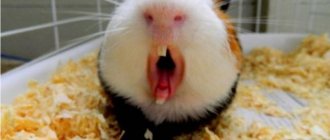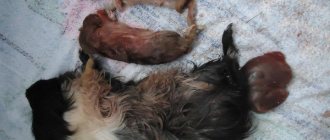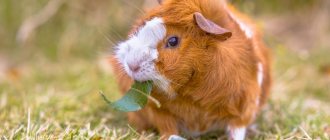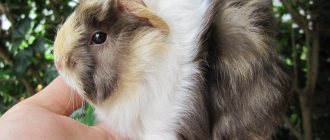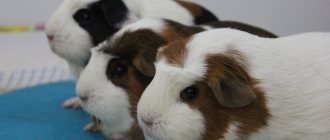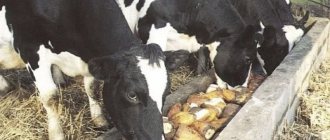Guinea pigs have long won the hearts of thousands of people. Of course, these small, funny creatures are easy to care for and have a very friendly character. Many guinea pig lovers purposefully purchase opposite-sex pairs of animals for further breeding. Indeed, this is an exciting activity, but before you decide to buy a pair of animals, study the topic thoroughly so that future piglets do not come as a surprise to you.
The best time for the first mating is 4-6 months
At what age and how often do they give birth?
Guinea pigs reach sexual maturity quite early. The best age for first mating in females is 4-6 months. Estrus lasts about 16 days, but the period when the female is ready for mating lasts only 8 hours. On average, guinea pigs give birth to 2 to 4 babies. Soon after giving birth, the pig may go into another heat cycle. At this point the female may be covered again. Thus, the female can feed already born offspring and at the same moment expect the next one.
How long does pregnancy last
If we talk about the pregnancy of all rodents, then guinea pigs have a longer period, up to 10 weeks. The average duration of pregnancy is 60-70 days, which can be influenced by several factors, such as the number of babies, fetal size and others.
It is worth saying that the duration, of course, is an individual indicator, for example, if a guinea pig bears 1-2 fetuses, then pregnancy can last up to 72 days, so there is no exact time frame for day-to-day millet.
How to tell if your guinea pig is pregnant
Unfortunately, it is very difficult to determine the pregnancy of a pet in the early stages. A simple amateur is unlikely to be able to do this. However, as the gestation period increases, the guinea pig begins to show some peculiarities in behavior and habits. In the second month of pregnancy, any owner of a guinea pig will be able to identify it, since the pet’s appearance will change significantly. But there are still a number of features that are worth paying attention to if you think that the pig is expecting offspring.
Increased appetite of a small animal
A pregnant guinea pig will drink much more water than usual. Accordingly, the female will eat more. Make sure there is always clean water and enough food in the cage. Be careful not to overfeed the animal, this can have unpleasant consequences.
No heat
In guinea pigs, estrus occurs quite often - once every 2 weeks. It is quite easy to notice this period: the pig will arch its back and purr when stroked. The female's vagina becomes moist and swollen. This will not happen during pregnancy.
Behavior change
The guinea pig becomes less mobile. The female begins to hide in a cage, build a house or bury herself in the hay. May not eat previously favorite foods. Becomes very aggressive towards the male.
Abdominal enlargement
Only starting from the 3rd week can you see a change in the size of the female’s abdomen. At this time, the stomach quickly increases in volume. From about 7 weeks you will be able to observe active movements in the female’s tummy. At the same time, you can count the number of cubs.
Loop change
The guinea pig's external genitalia swells. They increase in size and become loose.
Toilet
The guinea pig will relieve itself more often. This occurs because the bladder and intestines are compressed. At this stage, you should clean your guinea pig's home more often.
Animal weight gain
The female will quickly gain weight. By the time she gives birth, a guinea pig will have doubled her pre-pregnancy weight. It is important to keep a record of changes in the animal's weight. This is necessary to make sure that everything goes according to plan. You need to weigh the pig carefully so as not to accidentally damage the cubs.
Aggression towards relatives
Despite the fact that guinea pigs are very kind animals, during pregnancy females change their behavior greatly. A pregnant pig is extremely aggressive towards the male and other females. This happens because the pig protects future offspring.
A pregnant woman should be kept separately from her relatives
Behavior change
If you know your pet well and have often observed it, then you will notice changes in behavior immediately. The female moves less, one might say that she becomes lazy.
She tries to build herself a separate house, looks for a secluded corner and buries herself in the hay. Refusal of any treats may also occur. Can show aggression towards the male sex.
How to care for a pregnant guinea pig
To avoid premature birth or miscarriage, you need to protect the female from all possible stressful situations. To ensure a smooth pregnancy for the expectant mother, you need to:
- Keep the animal separately from its relatives. If you find out that your guinea pig is pregnant, put the rest of the pigs in another cage or any other prepared place. It is advisable to leave the pregnant female in the old cage. In a familiar place the animal will feel more calm. The cage should not be exposed to direct sunlight, and drafts should also be avoided.
- Remove all shelves, ladders and hammocks from the cage. This is necessary so that the pig does not have the opportunity to harm the offspring.
- Avoid loud screams and noise. Pigs are quite shy.
- Avoid bathing your pig . This is necessary to avoid stress in the animal.
- Lubricate the pig's belly with baby cream. During pregnancy, the pig's belly becomes dry, and microcracks often appear on it. The stomach should be lubricated daily.
- Protect the animal from unnecessary squeezing. It is extremely important to leave your pregnant guinea pig alone. You should not once again pick up the animal and pet it. However, if you have to do this, be careful.
- Let the animal go for a walk. If the pregnancy is going well, then you should let the pig walk freely around the room. This must be done in order to avoid obesity.
- Increase the portion of feed.
Have you tried breeding guinea pigs? Make sure that the pregnant woman always has fresh water
Offspring
Unlike other rodents, such as rats and hamsters, guinea pig babies are born with their eyes open, covered in fur, and with teeth erupting. Literally immediately after birth they begin to move independently.
Newborn guinea pigs
A good weight for a baby at birth ranges from 45-140 grams. If the weight is 40 grams or less, then there is a high probability of fetal death.
Also, the weight will depend on the number of cubs; the more babies, the less their weight. Accordingly, if the female has the first pregnancy, then the baby will be alone and his weight will be good.
Already in the first days, guinea pig babies begin to try food, repeating everything after their mother. The litter is transplanted into a separate cage about a month after birth.
Caring for piglets
It is not recommended to pick up babies in the first days after birth, but if this is necessary, you should thoroughly wash your hands before doing so.
To provide newborn pigs with optimal living conditions, it is enough to follow a few rules:
- If there are several babies in the litter, then several bowls and drinkers will be needed;
- The family's cage must be spacious. It is important that there are no gaps or large distances between the rods in order to prevent children from escaping or getting stuck;
- There is no need to rush to return previously removed ladders, hammocks, etc.;
- Just as during the female’s pregnancy, it is important that the cage is not exposed to sunlight and there is no draft. The room should be warm - 18-20 degrees;
- A couple of days after the birth of the pigs, you need to completely wash the cage. In the future, it is advisable to carry out disinfection several times a month;
- Of course, ensure peace and quiet, without sharp, loud sounds.
Brood diet
The mother pig feeds the babies with her milk for about a month; it is very nutritious and fatty. But, as already mentioned, copying their mother’s behavior, babies begin to try dry food and other solid foods early. In addition to food, you can include nuts and cereal flakes in your diet. What they do not have time to eat in a day should be removed, not including food, in order to avoid poisoning.
These animals are designed in such a way that it is normal for them to eat their mother’s feces. In them, the younger generation finds vitamin B and potassium, which are important for proper development and growth.
Selection of animals for breeding
When choosing a female and a male, first of all they pay attention to the health of both, so that the offspring are healthy.
It is important to avoid mating closely related individuals; such an experiment may be unsuccessful. There is a risk that the children will be weak and have health problems. The number of pregnancies in one female per year should not be more than two; the animal’s body needs time to recover. The health of the mother directly affects the health of the babies born.
It is better to choose guinea pigs of the same breed if there is no goal of mixed breeds. Basically, breeders prefer to maintain the quality of the offspring without crossing different representatives.
What to feed a pregnant guinea pig
During pregnancy, your guinea pig needs to carefully monitor its diet. Please note that the feed should contain a large amount of vitamins and microelements. This is very important, because properly selected nutrition will help the guinea pig bear and give birth to healthy offspring. However, you should not overfeed your pig. Give your animal more fruits and vegetables. Your pet's diet should contain the following elements:
- Granular feed. This is the best option for pregnant pigs . With this feeding, the animal receives all the necessary nutrients. Don't give your pig too much food. Pay attention to the instructions.
- Hay. It contains a huge amount of protein and calcium, which contributes to the proper development of the fruit.
- Water. Make sure your pet always has clean water in his cage. If possible, install several drinkers.
- Vegetables. Pregnant pigs need to eat a lot of vegetables. It is useful to give carrots, corn, cucumbers.
- Herbs. A pregnant pig can be offered parsley, lettuce, clover. Pay attention to the freshness of the herb offered.
- Fruits. Sometimes it’s worth pampering your pet with a delicious fruit. This could be a small amount of apple or strawberry.
- Milk, cottage cheese. Dairy products should be given no more than once a week.
- Vitamin C. Offer your pig tomato juice rich in this vitamin.
- Vitamin E. Your pig will happily eat grains of oats or wheat.
- Vitamins and minerals. A pregnant pig really needs supplements that contain many useful elements.
Before giving birth, your pig may have a decreased appetite
Selection of animals for breeding
To get strong, healthier offspring, you need to wisely select a pair for your rodent. Only clinically healthy animals are allowed for breeding. Guinea pigs must meet the following parameters:
- be active, mobile;
- have beautiful shiny fur, clear eyes;
- be moderately well-fed;
- have excellent breed qualities.
Animals suffering from obesity, chronic, congenital pathologies, defects, exhausted, sick rodents are not suitable for breeding. The weight of the female before mating should not be less than 700 grams. The expectant mother must be absolutely healthy and in excellent physical shape.
It is also not recommended to mate females who have not given birth and are older than one year, since the ligaments lose elasticity and the birth of a guinea pig can end in failure.
In order for the offspring to be born strong, healthy, and viable, female guinea pigs should not give birth more than twice a year. Males can be bred 2–4 times a year. In case of uncontrolled use of males, females will remain uncovered.
The best period for breeding guinea pigs is mid-spring and early summer. At this time there is a lot of varied and healthy food for rodents.
A week before the planned mating, you need to supplement the rodents’ diet with food that is rich in proteins, essential amino acids, vitamins A, E, C. Feed the pig sprouted wheat and high-quality cereals. Supplement your diet with succulent food, herbs, vegetables, and fresh hay.
How does childbirth go?
As a rule, guinea pigs give birth at the quietest time - at night. Childbirth lasts about an hour. In exceptional cases, a female can give birth for 5 - 6 hours. During labor, the guinea pig sits with its head tilted forward.
Usually females give birth silently, sometimes they may squeak a little. Piglets are born in a shell, which the mother tears off, after which she begins to lick the baby. After all the babies are born, the pig eats the shells and begins feeding the babies.
What to do after childbirth
When the birth is over, you should clean the cage without touching the newborn cubs. If there are dead cubs, they must be removed as soon as possible. Some females may eat them. This shouldn't happen. Don't forget to monitor mommy's diet. A nursing guinea pig needs a balanced diet. Nutrition during breastfeeding is not much different from what it was during pregnancy. Give your pig more grass, vegetables and healthy hay.
ATTENTION! Please note that piglets are born with teeth. This means that they can eat food on their own. But despite this, babies need their mother. They should not be separated, because the mother will feed them milk for a month.
No nutritional supplements can replace healthy mother's milk for piglets. Monitor the location of feeders and drinkers. They need to be positioned so that the piglets can reach them. The water must be fresh and clean. Change it every day. The cage must be arranged so that there is enough space for all new residents. If necessary, purchase new housing for the family
Weight gain
Of course, your beloved pet will gain weight; by the time she gives birth, the female will double her weight. It is recommended to regularly weigh the expectant mother and record her weight to monitor her normal condition.
When weighing, you need to be as careful as possible so as not to harm either the pet or the fetus; carry them very carefully.
